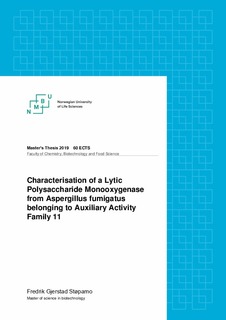| dc.description.abstract | Studies with lytic polysaccharide monooxygenases (LPMOs) in recent years have shown promising results in the enzyme’s ability to degrade recalcitrant carbohydrate biomass, a crucial property in future biomass utilization that have led to increasing interest for industrial purposes. The list of LPMO candidates with putative industrial applications continues to grow, with readily new characterized enzymes in the CAZy database. LPMOs are copper-dependent metalloenzymes that utilize an oxidative mechanism in degradation of polysaccharides. The intricate nature of the oxidation mechanism however, are hitherto unknown. Recent studies have found that LPMOs are able to utilize H2O2 as the catalytic co-substrate, and that this reaction is much faster than reactions using molecular oxygen (O2). These finding have led to the debate of whether H2O2 is the true, and only co-substrate for LPMOs, or if O2 also serve as a co-substrate. This study provides insight in enzymatic functions and structural arrangements of a novel LPMO from the AA family 11 (AfuLPMO11B) originating from Aspergillus fumigatus. AfuLPMO11B is a C1 oxidizing enzyme, active on α- and β- chitin substrates, with stable activity for 20+ hours on both substrates at 30 °C. The AA11 show great synergetic action with chitinase C (SmChi18C) when acting on α-chitin, and with an almost complete conversion of β-chitin to soluble products. Activity of the LPMO was boosted by adding H2O2 in reaction mixtures, yielding a so far maximum of 27-fold increase in catalytic rates from the apparent catalytic rate in standard aerobic conditions. The LPMO also show linear product formation up to 3 hours with 80 µM H2O2, and 6 hours with 50 µM H2O2 from acting on β-chitin substrate. Earlier studies utilizing H2O2 in LPMO reactions have indicated that LPMOs are able to repeat catalytic cycles only using only H2O2, after a first priming reduction. This ability was not observed for AfuLPMO11B. The enzyme binds equally well to α- and β-chitin in non-reduced state, with approximately 25 % bound protein after 6-hours of incubation. In glycosylated state with an N-linked glycan, the bound protein fraction is increased to 32 %, while reduced to 16 % on β, and α-chitin, respectively. Upon LPMO reduction, this binding trend is further increased. The N-glycan site is predicted to be on (Asn80), a residue that are not located close to the active site. AfuLPMO11B was crystallized, from which the protein structure was successfully elucidated from x-ray crystallography. The solved protein structure was similar to an earlier modelled structure which was used in structural studies. | nb_NO |

